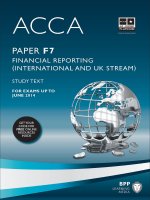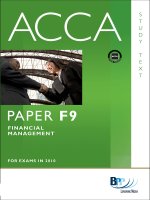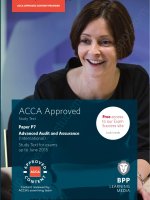Paper P2: Corporte Reporting - Study text
Bạn đang xem bản rút gọn của tài liệu. Xem và tải ngay bản đầy đủ của tài liệu tại đây (9.6 MB, 746 trang )
ACCA APPROVED
CONTENT PROVIDER
ACCA Approved
Study Text
Paper P2
Corporate Reporting
(International and United Kingdom)
Study Text for exams from
1 September 2015 to 31 August 2016
Free access
to our Exam
Success site
Look inside
ACCA APPROVED CONTENT PROVIDER
As the irst accredited publisher of ACCA materials, BPP Learning Media has set the benchmark for
producing exceptional study materials for students and tutors alike.
Our Study Texts, Practice & Revision Kits and i-Passes (for ACCA F1/FIA FAB, ACCA F2/FIA FMA, ACCA F3/
FIA FFA and ACCA F4) are reviewed by the ACCA examining team and are written by our in-house authors
with industry and teaching experience who understand what is required for exam success.
EXAM SUCCESS SITE
To help maximise your chances of succeeding in your exams, we’ve put together a suite of exclusive ACCA
resources. Our Exam Success site provides you with access to a free digital version of this publication, as
well as extra resources designed to focus your efforts on exams and study methods.
To access the Exam Success site, please email with the subject line “Access to Exam
Success site - eBook”, including your order reference number and the name of the book you’ve bought (ie
ACCA F7 Study Text) for your access code. Once you have received your code, please follow the instructions
below:
To access the BPP ACCA Exam Success site for this material
please go to:
www.bpp.com/ExamSuccessSite
n Create a user account if you don’t already have one.
Make sure you reply to the conirmation email.
n Log in using your registered username and password.
Select the paper you wish to access.
n Enter the code you received when prompted. You will only
have to do this once for each paper you are studying.
S
T
U
D
Y
T
E
X
T
PAPER P2
CORPORATE REPORTING
(INTERNATIONAL AND
UNITED KINGDOM)
BPP Learning Media is an ACCA Approved Content Provider. This means we work
closely with ACCA to ensure this Study Text contains the information you need to pass
your exam.
the
how each chapter links to the syllabus and the study guide
in the syllabus and the
lots of
you need
demonstrating what is expected of you in the exam
in regular
in
in our
in our
BPP's Practice & Revision Kit also supports this paper.
First edition 2007
Eighth edition April 2015
ISBN 9781 4727 2680 3
(Previous ISBN 9781 4727 1086 4)
e-ISBN 9781 4727 2758 9
All rights reserved. No part of this publication may be
reproduced, stored in a retrieval system or transmitted, in
any form or by any means, electronic, mechanical,
photocopying, recording or otherwise, without the prior
written permission of BPP Learning Media Ltd.
We are grateful to the Association of Chartered Certified
Accountants for permission to reproduce past
examination questions. The suggested solutions in the
practice answer bank have been prepared by BPP
Learning Media Ltd, unless otherwise stated.
A catalogue record for this book
is available from the British Library
BPP Learning Media Ltd
BPP House, Aldine Place
142-144 Uxbridge Road
London W12 8AA
www.bpp.com/learningmedia
Ricoh UK Ltd.
Unit 2
Wells Place
Merstham
RH1 3LG
Your learning materials, published by BPP Learning
Media Ltd, are printed on paper sourced from
traceable, sustainable sources.
ii
©
BPP Learning Media Ltd
2015
Contents
Page
Introduction
Helping you to pass
Studying P2
Important note for UK students
The exam paper
v
vii
viii
xxxiii
Part A Regulatory and ethical framework
1
2
Financial reporting framework
Professional and ethical duty of the accountant
3
37
Part B Accounting standards
3
4
5
6
7
8
9
10
11
Non-current assets
Employee benefits
Provisions, contingencies and events after the reporting period
Income taxes
Financial instruments
Leases
Share-based payment
Performance reporting
Related parties
69
115
137
153
181
237
257
271
329
Part C Group financial statements
12
13
14
15
16
17
Revision of basic groups
Complex groups and joint arrangements
Changes in group structures
Continuing and discontinued interests
Foreign currency transactions and entities
Group statements of cash flows
339
385
411
439
447
469
Part D Developments in reporting
18
19
20
21
Environmental and social reporting
Current developments
Reporting for specialised entities
Reporting for small and medium-sized entities
Practice question and answer bank
Mathematical tables
Index
Review form
495
523
549
575
589
679
683
Contents
iii
A note about copyright
Dear Customer
What does the little © mean and why does it matter?
Your market-leading BPP books, course materials and e-learning materials do not write and update
themselves. People write them: on their own behalf or as employees of an organisation that invests in this
activity. Copyright law protects their livelihoods. It does so by creating rights over the use of the content.
Breach of copyright is a form of theft – as well as being a criminal offence in some jurisdictions, it is
potentially a serious breach of professional ethics.
With current technology, things might seem a bit hazy but, basically, without the express permission of
BPP Learning Media:
Photocopying our materials is a breach of copyright
Scanning, ripcasting or conversion of our digital materials into different file formats, uploading
them to Facebook or emailing them to your friends is a breach of copyright
You can, of course, sell your books, in the form in which you have bought them – once you have finished
with them. (Is this fair to your fellow students? We update for a reason.) Please note the e-products are
sold on a single user licence basis: we do not supply ‘unlock’ codes to people who have bought them
second-hand.
And what about outside the UK? BPP Learning Media strives to make our materials available at prices
students can afford by local printing arrangements, pricing policies and partnerships which are clearly
listed on our website. A tiny minority ignore this and indulge in criminal activity by illegally photocopying
our material or supporting organisations that do. If they act illegally and unethically in one area, can you
really trust them?
iv
Helping you to pass
BPP Learning Media – ACCA Approved
Content Provider
As an ACCA Approved Content Provider, BPP Learning Media gives you the opportunity to use study
materials reviewed by the ACCA examination team. By incorporating the examination team’s comments
and suggestions regarding the depth and breadth of syllabus coverage, the BPP Learning Media Study
Text provides excellent, ACCA-approved support for your studies.
The PER alert
Before you can qualify as an ACCA member, you not only have to pass all your exams but also fulfil a three
year practical experience requirement (PER). To help you to recognise areas of the syllabus that you
might be able to apply in the workplace to achieve different performance objectives, we have introduced
the ‘PER alert’ feature. You will find this feature throughout the Study Text to remind you that what you
are learning to pass your ACCA exams is equally useful to the fulfilment of the PER requirement.
Your achievement of the PER should now be recorded in your on-line My Experience record.
Tackling studying
Studying can be a daunting prospect, particularly when you have lots of other commitments. The
different features of the text, the purposes of which are explained fully on the Chapter features page, will
help you whilst studying and improve your chances of exam success.
Developing exam awareness
Our Texts are completely focused on helping you pass your exam.
Our advice on Studying P2 outlines the content of the paper, the necessary skills you are expected to be
able to demonstrate and any brought forward knowledge you are expected to have.
Exam focus points are included within the chapters to highlight when and how specific topics were
examined, or how they might be examined in the future.
Using the Syllabus and Study Guide
You can find the syllabus and Study Guide on pages ix – xxxii of this Study Text.
Testing what you can do
Testing yourself helps you develop the skills you need to pass the exam and also confirms that you can
recall what you have learnt.
We include Questions – lots of them – both within chapters and in the Practice Question Bank, as well as
Quick Quizzes at the end of each chapter to test your knowledge of the chapter content.
Introduction
v
Chapter features
Each chapter contains a number of helpful features to guide you through each topic.
Topic list
Topic list
Syllabus reference
What you will be studying in this chapter and the relevant
section numbers, together with ACCA syllabus references.
Introduction
Puts the chapter content in the context of the syllabus as
a whole.
Study Guide
Links the chapter content with ACCA guidance.
Exam Guide
Highlights how examinable the chapter content is likely to
be and the ways in which it could be examined.
Knowledge brought forward from earlier studies
What you are assumed to know from previous
studies/exams.
FAST FORWARD
Summarises the content of main chapter headings,
allowing you to preview and review each section easily.
Examples
Demonstrate how to apply key knowledge and
techniques.
Key terms
Definitions of important concepts that can often earn you
easy marks in exams.
Exam focus points
When and how specific topics were examined, or how
they may be examined in the future.
Formula to learn
Formulae that are not given in the exam but which have to
be learnt.
Gives you a useful indication of syllabus areas that
closely relate to performance objectives in your Practical
Experience Requirement (PER).
vi
Introduction
Question
Gives you essential practice of techniques covered in the
chapter.
Case Study
Real world examples of theories and techniques.
Chapter Roundup
A full list of the Fast Forwards included in the chapter,
providing an easy source of review.
Quick Quiz
A quick test of your knowledge of the main topics in the
chapter.
Exam Question Bank
Found at the back of the Study Text with more
comprehensive chapter questions. Cross referenced for
easy navigation.
Studying P2
Paper P2 Corporate Reporting is a tough paper, reflecting the demands that will be made upon the
professional accountant in his or her working life. At the Fundamentals level, you will have studied the
essentials of financial statement preparation and analysis, including those of group accounts. At the
Professional level, these essentials will be assumed knowledge. You will be required to apply them,
assuming the role of a professional adviser and analyst to the management as well as the shareholders
and other stakeholders.
1 What P2 is about
The P2 syllabus comprises eight main areas:
A
B
C
D
E
F
G
H
The professional and ethical duty of the accountant
The financial reporting framework
Reporting the financial performance of entities
Financial statements of groups of entities
Specialised entities
Implications of changes in accounting regulation on financial reporting
The appraisal of financial performance and position of entities
Current developments
There is, of course, some overlap between these areas. For example, if you are discussing current
developments (H), you might be talking about the proposed changes to accounting for business
combinations (D) and considering the implications of changes in accounting regulation (F) and perhaps
even the ethical duty of the accountant to report those changes fairly and accurately (A).
2 Skills you have to demonstrate
At the Fundamentals level, the questions would be more easily categorised into syllabus areas. However,
at this level you may need to demonstrate knowledge, skills and thinking from outside the syllabus area
that the question seems to be about on the surface. The examination team has stated:
Students should be capable of relating professional issues to relevant concepts and practical
situations. The evaluation of alternative accounting practices and the identification and
prioritisation of issues will be a key element of the paper. Professional and ethical judgement will
need to be exercised, together with the integration of technical knowledge when addressing
corporate reporting issues in a business context.
So the paper is not predictable. That said, clear guidance has been given. The compulsory Section A
question, worth 50 marks, will always be on group accounts. It will also deal with issues in financial
reporting and will be case study based. In Section B, questions could be on any area of the syllabus, but
we have been told that two questions will be scenario based and one question will be an essay. You have a
choice of two from three.
Increasingly, questions are discursive rather than numerical, so it is vital that you get practice at
answering this type of question.
Introduction
vii
Important note for UK students
If you are sitting the UK P2 paper you will be studying under International standards and up to 20 marks
will be for comparisons between International and UK GAAP. The ACCA UK Syllabus and Study Guide
gives the following advice:
International Financial Reporting Standards (IFRS) are the main accounting standards examined in the
preparation of financial information. The key differences between UK GAAP and International Financial
Reporting Standards are looked at on a subject by subject basis. The comparison between IFRS and
UK GAAP will be based on the new UK GAAP as set out in FRSs 100-102, so the standard by standard
comparisons that appeared in previous editions of this study guide are now combined in outcome C11
(d): Discuss the key differences between the IFRS for SMEs and UK GAAP.
This Study Text covers all the topics you need to know under International Financial Reporting Standards.
An online supplement will be available at www.bpp.com/learning-media, covering the additional UK issues.
Exam technique for P2
Do not be needlessly intimidated
There is no shortcut to passing this exam. It looks very difficult indeed, and many students wonder if they
will ever pass. But many do. How do they do this?
Easy marks
All the questions are demanding, but there are many easy marks to be gained. Suppose, for example, you
had a consolidated statement of cash flows with a disposal, some foreign exchange complications and an
impairment calculation. There will be easy marks available simply for the basic cash flow aspects, setting
out the proforma, setting up your workings, presenting your work neatly. If you recognise, as you should,
that the disposal needs to be taken into account, of course you will get marks for that, even if you make a
mistake in the arithmetic. If you get the foreign exchange right, so much the better, but you could pass the
question comfortably omitting this altogether. If you’re short of time, this is what you should do.
Be ruthless in ignoring the complications
Look at the question. Within reason, if there are complications – often only worth a few marks – that you
know you will not have time or knowledge to do, cross them out. It will make you feel better. Than tackle
the bits you can do. This is how people pass a seemingly impossible paper.
Answer all questions and all parts of questions
The examination team frequently comments that students don't do this, so they miss easy opportunities to
gain marks.
Be ruthless in allocating your time
At BPP, we have seen how very intelligent students do one almost perfect question, one averagely good
and one sketchy. For a fifty mark question, the first twenty marks are the easiest to get. Then you have to
push it up to what you think is thirty to get yourself a clear pass. For a twenty-five mark question, the first
eight to ten marks are the easiest to get, and then you must try to push it up to fifteen.
Do your best question either first or second, and the compulsory question either first or second. The
compulsory question, being on groups, will always have some easy marks available for consolidation
techniques.
viii
Introduction
Syllabus and Study Guide
The P2 syllabus and study guide can be found below.
International
Introduction
ix
x
Introduction
Introduction
xi
xii
Introduction
Introduction
xiii
xiv
Introduction
Introduction
xv
xvi
Introduction
Introduction
xvii
xviii
Introduction
Introduction
xix
xx
Introduction
United Kingdom
Introduction
xxi
xxii
Introduction
Introduction
xxiii









